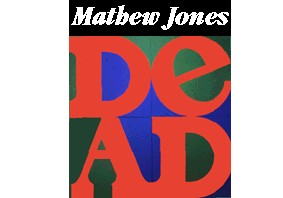

| Perhaps because queer people
are good de-cipherers and consumers of signs, queer
people love to wear them. There's an industry of queer
kitsch meeting the demand to declare and be counted as
queer and proud, usually in the context of gay and
lesbian festivals and major events where the presumption
is already one of being out and proud. Rainbow flags have
flourished as have T-shirts whose various rhetorical
forms are of the closet kind: "I'm not gay but my
boyfriend is", "Nobody knows I'm gay" are
just two of the favoured forms which extract their humour
from the logic of disclosure and deflection peculiar to
the glass closet. But there's one T-shirt slogan which seems to exceed the boundaries of its intended witty rhetorical effect. "The Family Tree Stops Here." It has a literal dead-pan ring to it. Sure enough, the aphorism has its sights set on heterosexual culture's ability to think itself endlessly through the ideology of the family, love, unity and normality. And underwriting the assault is the poleaxe of the sodomite whose non-procreative practices explain much of the irony. What has always seemed problematic though was the way that the slogan backfired on the wearer, a further irony generated out of the narrative of death implied in the full-stoping of the family's genealogy. The sign ricochets off its appointed target - the bourgeois and ideal family - it backfires placing him, the one who will die, precariously close to a gay/AIDS body where death always seems to come too soon. The aphorism, "The Family Tree Stops Here", is a maverick of meaning which instils both a sense of radical, sexual otherness against the norms of the straight biological family. But it also encapsulates what Eve Sedgwick called the "fatal bond in the heterosexist" imaginaire - the daydream of a world without queers.1 In the same way, Mathew Jones's entrance into the lineage of signs formed out of Robert Indiana's LOVE with DEAD says "The Family Tree Stops Here." LOVE's family tree is a prodigious one with each generation extracting its pound of signification from the simple, bombastic strength of four letter words. Indiana's LOVE embodied the aspirations of the tripped-out 60s only to become a merchandiser's windfall from which Indiana complained, he never profited. The story of LOVE, as Paul Taylor once remarked, "turned its creator into a metaphor of his time," but as metaphors have a habit of doing, LOVE, concealed more than it revealed. While it represented the ideal aspirations of a generation, Indiana lost control over the work and was gradually ostracised from New York's Pop Art scene-queens, becoming a recluse in a fishing village where he was further persecuted by small-town authorities for procuring homosex for money.2 While LOVE embodied the artists idealism in the 60s, its universalist aspirations have been re-embodied in the 80s and 90s through a more critical rethinking of queer/gay sensibility. The four letters have been displaced by AIDS in works by Australian-Chilean artist, Juan Davila and the Canadian collective, General Idea. It worked as the grounds for ACT-UP to mobilise discontent over government negligence for those effected by HIV/AIDS in STONEWALL '69, RIOT, AIDS CRISIS '89 and has been used by Queer activists to reliberate FUCK. Jones's relationship to this family of signs is, however, ambivalent, distracted and critical. Although all the key signifiers of are in place, such as the four letter words, the red, blue and green schema, the individualised italic letters, even the type face and various modes of the mediums in which those later displacements of LOVE took place, the anxieties about what a post-Indiana generation might mean by RIOT, FUCK and AIDS, are staged to reveal a conflict at the very point at which they are most assured of meaning what they are supposed to. Obvious intention and its effect are everything in these works. If, for example, ACT-UP's real purpose was to incite a riot by remodelling Indiana's LOVE with RIOT then ACT-UP's failure at least in an Australian context, was in thinking RIOT by recourse to its own radical Stonewellian legacy. ACT-UP, in effect, placed too much faith in a theology of signs and its own liberational philosophy embedded in the history of drag-queen revolutionaries. Jones marks the limit of liberational ideology in 69/96. . .A BRIEF HISTORY OF TURNING THE SAME THINGS UPSIDE DOWN AND BACK TO FRONT WITHOUT REALLY CHANGING VERY MUCH. But in a fiat that has become something of a signature discourse for Jones, his critique of gay signs itself opens up to different ways for rethinking the political in queer culture. 69 might be the ideological limit of the liberational gay movement but 96 is its future possibility. There is a syncopated questioning repeated in many of these works whose power is place to the viewer at the dead-end of discourse and political efficacy, while opening up to the question of a radicalised future. DEAD so then what . . . LOST so then what . . . CUTE so then what . . . The Family Tree Stops Here. Do even queers dream of a world without queers? I hesitate to ask the question thinking of the implications and how the question itself could be so readily misunderstood. Of course, queers dream of a world without queers. While developing counter-strategies, marking sexual differences visually, queers also dream of a world where queer would make no difference. And this is what links it with the epistemological and political histories of the liberational movements of the 60s and 70s. But given that it has become increasingly difficult to distinguish queer from the not so queer, the cause from the effect, LOVE from DEAD, the lines often drawn around identity are diffuse. It is around these lines that Jones complicates out familiarities with art historical and popular signs. Robert Schubert References |